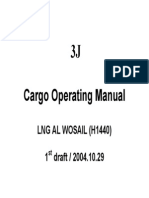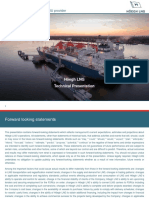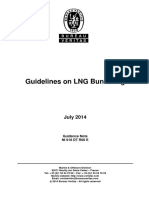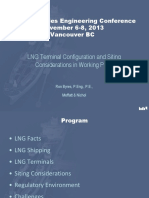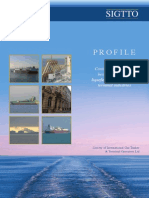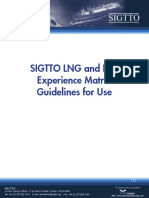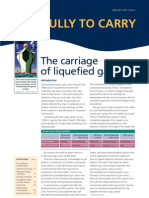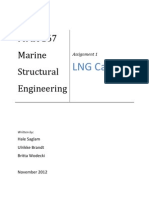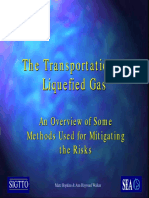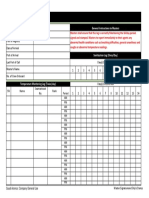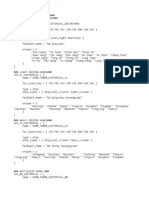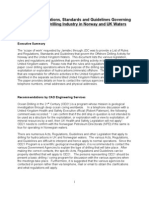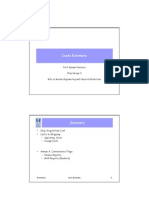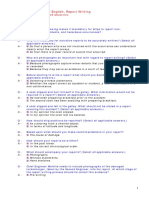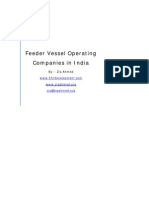LNG Vessel Safety Zones
LNG Vessel Safety Zones
Uploaded by
nguyenhung_pvCopyright:
Available Formats
LNG Vessel Safety Zones
LNG Vessel Safety Zones
Uploaded by
nguyenhung_pvCopyright
Available Formats
Share this document
Did you find this document useful?
Is this content inappropriate?
Copyright:
Available Formats
LNG Vessel Safety Zones
LNG Vessel Safety Zones
Uploaded by
nguyenhung_pvCopyright:
Available Formats
-1-
LNG Vessel Safety Zones
Safety Zones for LNG Carriers
In Atlantic Canada
Purpose: ...............................................................................................................2
Background:..........................................................................................................3
Scope of control zones: ........................................................................................6
Exclusion zone...............................................................................................6
Application ............................................................................................................9
Justifications......................................................................................................9
Threats ............................................................................................................12
International ....................................................................................................14
Local Situation:................................................................................................17
Options ...............................................................................................................19
Option A ..........................................................................................................19
Option B ..........................................................................................................20
Option C ..........................................................................................................22
Conclusions ........................................................................................................23
Annex A:..........................................................................................................25
A presentation for the Atlantic LNG and CNG Symposium,
June 27 and 28, 2005,
Halifax, N.S.
Opinions or assertions expressed in this paper are solely those of the author and do not
necessarily reflect the views of the Government of Canada.
Transport Canada Marine Safety
Atlantic Region
Prepared by Richard Cobanli
-2-
LNG Vessel Safety Zones
Purpose:
This paper has been prepared to discuss safety zones for LNG carriers
operating to and from the proposed Atlantic Canadian LNG receiving terminals.
The requirement for this paper evolved from the work of the TERMPOL Technical
Review Process (TRP) in order to satisfy marine safety requirements and provide
direction to project proponents and other stakeholders. To achieve this objective,
research into the activities and requirements of other ports and regions was
conducted with findings appropriately noted. Further, this research sought to
determine if any changes were necessary to ensure safe navigation, secure
operations and compatibility with functioning of other facilities established in the
region.
As a conclusion to this work, options are presented that either maintain,
augment or supersede existing procedures and protocols for vessel operations in
the region. The optimum solution will provide for a reasonable, practical system
of safety zone controls for large vessels to ensure the safest possible passage of
all vessel traffic using the region’s waterways, harbours and ports.
Transport Canada Marine Safety
Atlantic Region
Prepared by Richard Cobanli
-3-
LNG Vessel Safety Zones
Background:
While a new venture in Canada, the marine transportation of LNG is a
mature industry sector worldwide with a fleet of over 1000 specialty vessels
serving a network of export and import terminals. Vessels have become
significantly larger while technology has advanced in every aspect of design,
engineering, construction and operations. Current standard vessel sizes of 135K
cubic meters cargo capacity will give way in a few short years to vessels
reaching 250K cubic meters. All new terminals proposed in Canada are being
designed to accommodate these new larger vessels.
Being a new and still unfamiliar industry in Canada, LNG shipping and its
unique characteristics are subject to a great deal of attention as the Canadian
marine industry and society seeks to better understand the transportation issues
for this prized energy source. Transport Canada Marine Safety (TCMS) is
committed to promoting robust safety standards for the shipping industry
commensurate with the risks associated with the marine transportation of LNG.
In harmony with other government agencies sharing responsibilities for the
analysis of environmental, operational and social risks and benefits arising from
the construction and operation of a new facility, TCMS is focused on safety of
navigation and marine pollution prevention through a detailed marine risk
assessment called TERMPOL.
Transport Canada Marine Safety
Atlantic Region
Prepared by Richard Cobanli
-4-
LNG Vessel Safety Zones
“The ‘Technical Review of Marine Terminal Systems and Transhipment
Sites’ (TERMPOL Technical review process) focuses on a dedicated design
ship’s selected route in waters under Canadian jurisdiction to it’s berth at a
proposed marine terminal or trans-shipment site and, specifically, to the process
of cargo handling between vessels, or off-loading from ship to shore or visa-
versa.”
“The intent of the TERMPOL is to ameliorate, where possible, those
elements of a proposal which could, in certain circumstances, threaten the
integrity of the ship’s hull and its cargo containment system and consequently,
the environment in the vicinity of the design ship when navigating in waters under
Canadian jurisdiction.”1
Through conducting a TERMPOL TRP and environmental assessment
process prior to issue of the necessary permits, the subject of safety and security
exclusion zones have been identified as needing deliberation and definition.
Application of safety, security or exclusion zones are found at every port and
terminal to some degree however, their rational, scope and application vary
considerably. SIGTTO, an association of ship and terminal operators dedicated
to safe and reliable operation within a sound environment2, defines safety zones.
“…an area of sea space is established around the tanker into which no
other traffic is permitted to enter. Hence the tankers progress will never be
immediately hindered by encounters with other traffic, nor will it encounter traffic
having the potential to penetrate its hull.
The dimensions and shape of an exclusion zone should be determined in
the context of the specific conditions of the port.”3
1
TERMPOL Review Process 2001, Transport Canada TP743E, part 1
2
SIGTTO mission statement
3
LNG Operations in Port Areas, Best Practises for the industry, SIGTTO, Witherby’s Publishing, 2003,
p15
Transport Canada Marine Safety
Atlantic Region
Prepared by Richard Cobanli
-5-
LNG Vessel Safety Zones
In Canada, seven LNG receiving terminal projects are presently at various
stages of design development, approval and construction. This paper was
initiated based on the circumstances surrounding safe navigation and operation
at the projects under review in Atlantic Canada. The proposed locations are, for
the most part, heavily industrialised with existing oil terminals, gypsum, coal,
aggregates, paper, forest products and other general cargo imported and
exported to and from the region. Shipping details and patterns have been
reviewed in the proponent’s project scoping and Environmental Assessment
documents and therefore will not be revisited in this paper.
In support of safe navigation for all marine traffic serving the industrial
import and export activities in the region, vessel traffic control systems (VTS)
have been in place for many years. There are also established IMO adopted
traffic separation routing schemes in the approaches and entrances to most
proposed ports. All vessels greater than 20m LOA are required to comply with
and participate in the systems. The ports and approaches are compulsory
pilotage zones (with one exception) served by the Atlantic Pilotage Authority for
Canadian vessels over 1500 GRT and all foreign vessels however, subject to
certain exceptions as described in Annex A. Therefore, with few exceptions, all
marine traffic in the region is well monitored and controlled by Coast Guard and
marine pilotage services.
Transport Canada Marine Safety
Atlantic Region
Prepared by Richard Cobanli
-6-
LNG Vessel Safety Zones
Scope of control zones:
The terms safety zone and exclusion zone have been liberally applied in
many arenas without a uniform appreciation of what they are or the implications
of such. Generically, safety zone best describes the regulated or controlled
space around a ship when in transit, at an anchorage or alongside the pier.
From the TCMS publication “Routing Standards TP 1802”, definitions are
provided as they deal with routing systems. Routing systems developed under
this standard may or may not be adopted by the IMO, however, if they are IMO
adopted, they then become part of the international program of ship routing
systems. IMO adopted routing systems exist in the approaches and entrance to
the Bay of Fundy and Chedabucto Bay. While not directly applicable in the two
specific VTS systems noted the following definitions are taken from the quoted
publication for consideration when assessing the requirement and scope of any
safety zone.
Exclusion zone
An exclusion zone is an area within defined limits which is
prohibited for certain ships to keep them far enough offshore to give
sufficient time to rescue a disabled ship from going ashore and to protect
the coastline from any pollution caused by a casualty.
Security Zone
A security zone is a defined area, which for safety and
environmental purposes access is limited to persons, ships or objects
authorized by the Coast Guard. Such a zone may be stationary and
Transport Canada Marine Safety
Atlantic Region
Prepared by Richard Cobanli
-7-
LNG Vessel Safety Zones
described by fixed limits, or it may be described as an area around a ship
or object in transit.4
The conduct of vessels within an adopted traffic separation scheme and
routing system is governed by the Collision Regulations globally as well as in the
subject regional waters with the addition of Canadian modifications. All vessels
entering Canadian waters must be familiar with the requirements and carry
complete information respecting the local systems, routes and procedures as
they would for any port visited elsewhere.
Canada Standards Association C-Z276 “establishes essential
requirements and minimum standards for the design, installation, and safe
operation of LNG facilities” however does not address the marine shipment of
LNG. It does require that a dock used for the transfer of LNG to or from a ship
must be no less than 30 meters from any bridge crossing a navigable waterway
and the loading / unloading manifold is no less than 61 m from such a bridge.5
From the USA statutes 33CFR-165 (the regulations dealing with regulated
navigational areas), definitions provide clarification on the types of zones that are
applied in US waters and under the jurisdiction of the USCG.
Safety Zones
“ A safety zone is a water area, shore area, or water and shore area to
which, for safety and environmental purposes, access is limited to
authorized persons, vehicles, vessels. It may be stationary and described
by fixed limits or it may be described as a zone around a vessel in motion”
4
TCMS Publication #TP 1802, Routing Standards 1991
5
CSA Z-276, July 2003.
Transport Canada Marine Safety
Atlantic Region
Prepared by Richard Cobanli
-8-
LNG Vessel Safety Zones
Security Zones
“(a) A security zone is an area of land, water or land and water which is so
designated by the captain of the port or district commander for such time
as is necessary to prevent damage or injury to any vessel or waterfront
facility, to safeguard ports, harbours and territories, or waters of the United
States or to secure the observance of the rights and obligations of the
United States.
(b) The purpose of a security zone is to safeguard from destruction, loss
or injury from sabotage or other subversive acts, accidents, or other
causes of a similar nature:
(1) Vessels,
(2) Harbours,
(3) Ports, and
(4) Waterfront facilities:
In the United States and all territory and water, continental or insular, that
is subject to the jurisdiction of the United States.”6
In the above definitions please note the distinction between safety and
security although the spaces described are essentially the same. The regulations
arising from these definitions allow the USCG ‘Captain of the port’ (COTP) or
District Commander’ the authority to make rules for the application of controls or
restrictions on vessel movements in waters, harbours and roadstead, at
anchorage and alongside the pier.
6
USA statutes 33CFR-165
Transport Canada Marine Safety
Atlantic Region
Prepared by Richard Cobanli
-9-
LNG Vessel Safety Zones
Application
The application and scope of controlled zones for LNG vessels has been
diverse in different jurisdictions depending on the calculated risk. One has only to
look at ports such as Boston, USA and Barcelona, Spain to see the range of
safety zone controls applied to LNG carriers and other traffic transiting and using
LNG facilities and adjacent waterways. For example, in brief, the port of Boston
restricts all other traffic movement in the area, closes overlying road bridges and
adjusts flight paths for aircraft approaches to and from the nearby international
airport. Additionally, the USCG provides, at cost, aerial and marine escort and
surveillance throughout the harbour passage and port turnaround period of an
LNG carrier at the Everett terminal. On the other hand, traffic movements in the
port of Barcelona continue as normal regardless of the presence of an LNG
carrier.
Justifications
The determination of need for safety zones can be broken into three
specific themes however; the application is essentially the same. Ultimately, the
function of the zones is to maintain the integrity of the vessel, terminal,
community, personnel and other neighbouring facilities, places or vessels
operating in or transiting through adjacent waters.
Transport Canada Marine Safety
Atlantic Region
Prepared by Richard Cobanli
- 10 -
LNG Vessel Safety Zones
1. Safety zones can be established for navigation safety when
underway in transit as addressed through the use of traffic
separation schemes, vessel traffic control systems and the isolation
of vessels underway, anchored or berthed. The intent is to create
an appropriately sized space around the vessel to minimise the risk
of hindrance from or collision with another vessel or grounding.
2. The next safety zone application is for the protection of both
adjacent property, personnel and vessels from accidental or
operational spill or other unplanned events such as cargo leakage
as well as elimination of ignition sources from the leakage and spill
areas. For example, the release of LNG overboard with the
resulting cryogenic issues, vaporisation and risk of pool fires would
be detrimental to health and safety of passing craft up to a
calculated plume dispersion distance. Therefore imposition of a
safety zone for the protection of all things and people external to
the ship may be considered. Application of safety zone in this case
would provide protection for small vessels, fishing craft, yachts,
tugs, service craft and any other vessels likely to pass at a close
distance. Elimination of potential ignition sources within the plume
Transport Canada Marine Safety
Atlantic Region
Prepared by Richard Cobanli
- 11 -
LNG Vessel Safety Zones
area is also a critical factor in determining this safety zone for the
vessel alongside the pier and at anchorage.
3. Security zones can be applied to vessels to create a sterile area
around a vessel for security purposes. Prohibiting any vessels,
vehicles or personnel within a defined area when underway,
anchored or alongside provides a visible buffer whereby anyone
entering could be considered entering for the purpose of terrorism
or other malicious intent. This type of security zone must be actively
enforced if it is to have any effect and does go beyond the normal
scope of vessel operations. Security zones could be applied under
the requirements of a port or ship security activation of MARSEC
levels 2 or 3 under the ISPS code. The intent of a security zone
would be to ensure a space around the ship is maintained as a
buffer or no-go zone in order to minimize the likelihood of any
undesirable entity contacting the vessel. The security zone for
potential targets such as LNG carriers, allows for an intervention
period against the approaching vessel or craft such as in the case
of a military vessel secured alongside a pier at a naval base
maintaining an active security perimeter with on-water patrols. This
requires an intervention capability such as high-speed small craft,
police, military etc. The determination of the security zone will be
Transport Canada Marine Safety
Atlantic Region
Prepared by Richard Cobanli
- 12 -
LNG Vessel Safety Zones
carried out during the proponent’s security assessment and
planning exercise leading to ISPS certification of the terminal by the
TC Security directorate.
The overall rational is simply safeguarding a cushion or buffer zone
around the vessel. The conventional approach to this solution is through the use
of VTS and separation zones, compliance with Collision regulations, compulsory
pilotage, escort and assist tugs and development of operational manuals with
predetermined decisions satisfying urgent and emergency situations. Therefore,
the requirement and scope for safety zones around LNG carriers or other vessel
traffic in the subject area is brought into question.
Threats
Two scenarios drive the threats to vessel or environment. The first deals
with an accident or incident related to ship operation such as grounding, collision,
onboard or terminal deficiency; while the second threat category relates to an
external threat such as terrorist or other subversive activities such as bomb,
missile, pirate actions, ramming, etc.
Operational threats can be mitigated through controls, monitoring and
corrective actions. These components would be consistent with other shipping in
the area such as VLCC and ULCC traffic also using the same waterway.
Transport Canada Marine Safety
Atlantic Region
Prepared by Richard Cobanli
- 13 -
LNG Vessel Safety Zones
Similarly, an additional threat to local interests results from an operational or
accidental leak including those that may be relatively minor in nature. A leak of
LNG puts workers, crews or passing vessels at risk of exposure to the cryogenic
LNG. This event presents a serious risk of injury, death or structural failure of the
vessel due to the rapid cooling on contact and the absorption of heat away from
contacted bodies as the LNG flashes off to vapour and the likelihood of the
vapour cloud contacting an ignition source prior to dispersing into the
atmosphere. The vapour dispersion patterns and risks are thoroughly addressed
in the project proponent’s Environmental Assessment documents. Safety zones
provide a buffer around the ship and facilities to protect people and assets from
this potential however low it may be.
The recently released SANDIA Report concludes that:
Due to the existing design and equipment requirements for LNG Carriers,
and the implementation of navigation safety measures such as traffic
management schemes and safety zones, the risk of accidents is generally low.
The most significant impacts to public safety and property from an
accidental spill exist within approximately 250m of a spill, with lower impacts at
distances beyond approximately 750 m from a spill.
The potential breaching of an LNG cargo tank due to an accident, such as
a collision or grounding, appears to be minimal. Such a breach can be easily
reduced through a number of operational mechanisms, including managing ship
traffic, coordinating ship speeds, and by active ship control in inner and outer
harbours where the consequences of a potential LNG spill might be most
severe… Therefore, the safety and hazard issues that can lead to an accidental
breach appear manageable with current safety policies and practices.7
7
SANDIA Labs report 2004, p
Transport Canada Marine Safety
Atlantic Region
Prepared by Richard Cobanli
- 14 -
LNG Vessel Safety Zones
The second threat scenario, which describes the intentional subversive,
malicious or terrorist act on the vessel, would only serve the perpetrators cause if
there were a significant public or economic impact resulting from their actions.
The facilities in Atlantic Canada being remotely located offer little value to this
end as compared to other facilities in populated or industrialised areas such as
the Distrigas Corp. terminal in Boston. Therefore a reasonable observation
respecting the threat of an intentional act against a ship in Atlantic Canada would
be that, it may be unlikely and of little value. However, the proponent’s
preparation of an approved security assessment and security plan under the
requirements of the ISPS Code and Canadian Marine Transportation Security
Act and regulations would confirm the nature and scope of any security threat
exposure on facilities and calling vessels.
International
Research for this paper included an Internet review of international LNG
information sources, port contacts and anecdotal accounts from personnel
working in the industry. Several contacts have been established within the
industry that will continue to serve in supporting further dialogue, research and
analysis.
With few exceptions, the international approach to safety zones for LNG
carriers is not substantially different from other large tonnage vessels. Navigation
safety is the core issue surrounding the isolation of vessels in transit by way of a
Transport Canada Marine Safety
Atlantic Region
Prepared by Richard Cobanli
- 15 -
LNG Vessel Safety Zones
safe zone around the vessel. Security requirements, if different, are addressed
through the ISPS Code security plan requirements for ships and ports and would
be invoked when heightened security is required during MARSEC levels 2 or 3.
The American approach, given the high threat level exposure of their
facilities and society includes significant security protocols, in addition to the
basic navigation safety parameters described. US legislation through 33CFR 165
places a responsibility on the USCG Captain of the Port or District Commander
to identify the threats and risks, and implement operational and geographic
controls that defuse the perceived threat for the particular port, approaches and
vessels. This authority extends to include controls (through cooperation with
other responsible authorities) on adjacent areas that may allow access to the
target vessel such as road bridges, adjacent lands, airspace, and marine
waterways. Extensive monitoring and patrol form an integral part of that regime.
Further examples of safety and security zone applications in US ports
include the following:
• Cook Inlet, Alaska export terminal maintains a 1000 Yard radius zone
around its terminal and berthed ships. Ships transiting to and from the
terminal are protected by a 1000 Yard radius zone;
• Boston (Everett terminal) ships in transit are escorted with a safety and
security zone extending 1000 yards fore and aft and 100 yards each side;
• Cove Point, Chesapeake bay maintains a 500 yards radius zone around
the full extent of its large terminal and ships alongside;
Transport Canada Marine Safety
Atlantic Region
Prepared by Richard Cobanli
- 16 -
LNG Vessel Safety Zones
• Savanah River, Elba Is terminal is located in a narrow channel and so
presents a greater challenge. Ships less than 1600 GRT are not to
approach closer than 70 yards while larger ships must have two tug escort
throughout their passage in the area of the terminal.
Other international jurisdictions such as those of Western Europe, Britain
and Australia have not pursued the American model for safety and security
zones in their import and export trade of LNG or other hydrocarbons. National
legislation for safety zones is dealt with as in Canada with traffic control and
separation systems. Local requirements for safety zones are dealt with by the
harbour authorities in their own port specific procedures, manuals and systems.
Each port will perform a risk analysis and develop operations rules based on the
findings of the assessment. For example, the UK port of Milford Haven maintains
a moving exclusion zone around LPG vessels over 20,000 GRT. All ships lying
alongside any hydrocarbon berth enjoys a 100 m exclusion zone. The risk
analysis conducted determined controls for ship types, size and cargo hazard
potential therefore, all ship types and cargoes are considered in the analysis.
Transport Canada Marine Safety
Atlantic Region
Prepared by Richard Cobanli
- 17 -
LNG Vessel Safety Zones
Local Situation:
The proposed Atlantic Canadian sites are in relatively remote locations
adjacent previously industrialised areas and natural accessible ports. The
approaches are deep and wide however, as the course of the waterway leads to
the inner reaches of the harbours, the waters become relatively sheltered while
the predominant winds tend to follow the alignment of the shipping channels and
proposed wharf facilities. The sites enjoy many natural characteristics as well as
infrastructure components that contribute to their suitability for large vessel
shipping. A variety of vessels including many general cargo, dry bulk, and
tankers up to ULCC in size visit the region regularly.
Existing controls effecting the safe operation and traffic flow in the region
have been determined to be adequate for the existing volume and type of
shipping. Future changes in frequency, type and size of ships and introduction of
new cargoes and their inherent characteristics are presently under review as part
of the TERMPOL review and environmental assessment process and will define
any required changes needed to ensure continued safe operations.
Pilotage in the region, where compulsory, is by way of experienced pilots
engaged by the Atlantic Pilotage Authority. Local pilotage practice includes
slotting traffic in the narrow stretches of a waterway so as to avoid passing,
overtaking or close proximity meeting of large vessels. Timing of ship movements
Transport Canada Marine Safety
Atlantic Region
Prepared by Richard Cobanli
- 18 -
LNG Vessel Safety Zones
is planned and scheduled to ensure availability of pilots and the least potential for
conflict of vessels manoeuvring in the stream.
Deployment of tugs for escort, berthing and departure of vessels are
controlled by the pilots in order to support their planned ship movements. Tug
availability is presently aligned to local need and will require an increase in
number and capability to manage several additional large vessel movements
within a port area. Additional tug capacity will be required to stand-by for
emergency or heavy weather requirements particularly when two or more large
vessels are in the port area at the same time.
In addition to the procedural and communications protocols in place to
support local shipping, an extensive buoyage and beacon system has been in
place for many years. Leading lights and ranges mark the navigation channels
entering and leaving these ports. Prior to opening the LNG import terminal, a
review of terminal lighting will be required to ensure the piers are adequately
marked for navigation in the area and so that terminal lighting does not interfere
with other navigation aids, beacons etc serving the navigational channel.
Existing regulations, procedures and guidance notes are provided through
Notice to Mariners and other Canadian and International publications. These
sources provide critical quality information respecting the traffic control,
separation, and monitoring systems, communication and guidance information
for Mariners. Safety and security information including threats, traffic reports,
vessel movement controls etc. are currently distributed using these systems and
Transport Canada Marine Safety
Atlantic Region
Prepared by Richard Cobanli
- 19 -
LNG Vessel Safety Zones
will be fundamental in the application of any safety or security zones applied to
transiting, anchored or berthed vessels.
Options
The approaches to the regions proposed LNG receiving facilities already
enjoy an established network of navigational controls put in place for existing oil,
dry bulk, paper, general cargo and other import and export shipping. An analysis
of shipping traffic in the area of each proposed project is contained in the
proponent’s environmental assessment submission. Navigation and operation of
LNG carriers in the region shall be in accordance with international and Canadian
legislation. In addition, local pilots serving all compulsory pilotage vessels in the
area have established protocols for the movement of vessels through the region.
The following options are presented for discussion and represent a range of
solutions for the safety zone question.
Option A
The Chedabucto Bay, Strait of Canso and Bay of Fundy VTS and traffic
separation systems already support a significant volume of shipping traffic
serving several facilities in their areas including a variety of large and very large
tankers. The existing navigation support systems in place address the
requirements of the current volume and nature of traffic. As a first option for
Transport Canada Marine Safety
Atlantic Region
Prepared by Richard Cobanli
- 20 -
LNG Vessel Safety Zones
consideration, no changes are made to the existing systems. In this option, the
increase in shipping traffic volume is absorbed into the mix of vessels with no
additional measures taken to isolate or minimize risks of grounding or contact /
collision. The existing systems would apply equally to all forms of future shipping
including the passage of laden and light LNG carriers through the region.
Given the significant increase in traffic movements, the size and handling
characteristics of LNG carriers and the hazardous nature of the cargo carried,
this option may not be a viable solution.
Option B
The suggestions in this option are made to formalise and augment the
procedures for all vessels transiting and operating in the subject region. These
suggestions are provided for existing traffic in addition to the new LNG carrier
traffic in the region, as the requirement for safe vessel traffic management will
impact on all vessels equally. The following procedures could apply to all large
vessels such as, for example, those over 10,000 GRT when navigating in the
region and all vessels regardless of size operating in the vicinity of LNG carriers,
and other large traffic such as VLCC and ULCC traffic.
1. LNG vessels will execute a normal sea passage to Canadian waters, the
approaches to proposed harbours and in accordance with the local traffic
separation scheme and VTS;
Transport Canada Marine Safety
Atlantic Region
Prepared by Richard Cobanli
- 21 -
LNG Vessel Safety Zones
2. Pilot will embark at the outer pilot station and conduct the vessel within the
parameters of the VTS and traffic separation system to its inbound end;
3. Normal passage under pilot guidance throughout the approaches and
harbour manoeuvres;
4. Single vessel passage in inner harbour, narrow channels or restricted
areas. No vessels are permitted to pass or overtake in the course of this
passage.
5. Active tug escort including tug assist with a suitable number of high
capacity tugs during inner harbour manoeuvres and to the berth (to be
determined from modelling conclusions and subsequent design ship
analysis)
6. Minimum of 1 mile fore and aft distance between vessels transiting in
same direction;
7. Restrict all vessel movements during LNG carrier berthing, turning and
departure;
8. Minimum passing distance from an LNG carrier at anchorage and
alongside the unloading terminal pier should be 250m* for any other
vessels while in transit;
9. VTS control shall broadcast a local notice to shipping regarding the
operation of LNG or other very large traffic in the effected waters including
notice of passing distances and restrictions.
*
250 m suggested based on minimum safe distance conclusion in SANDIA report.
Transport Canada Marine Safety
Atlantic Region
Prepared by Richard Cobanli
- 22 -
LNG Vessel Safety Zones
Formalization of existing pilotage practises and development of a port
operations manual including the above basic parameters would provide a
reasonable and practical approach to safe vessel operation in the subject waters
with a minimum impact on the movement of existing traffic.
Option C
This option presents a more extreme approach similar to the USCG
protocols in certain US ports whereby navigation safety is overlaid with extensive
security precautions. The purpose being to prevent access to the LNG vessel
throughout its passage and visit in Canadian waters through absolute isolation. A
high security approach to a safety zone for an LNG carrier could include
suspension of all traffic in the area during the passage of the LNG vessel to and
from the terminal. This exclusion could extend seaward to the pilot station or
beyond. Given the relatively narrow channels adjacent the proposed terminals,
the shipping channels could be closed during the presence of the LNG carrier.
The unfortunate consequence of this high level of control is its negative impact
on other shipping in the region. Further, to be effective, this level of control
requires significant and onerous investments in monitoring, patrol and
enforcement as mentioned previously for the Distrigas Corp terminal in Boston
Transport Canada Marine Safety
Atlantic Region
Prepared by Richard Cobanli
- 23 -
LNG Vessel Safety Zones
Through proper analysis, evaluation of risks and preparation of the
required port and ship security plan, a lesser level of security threat during
normal operations would likely make this degree of control unnecessary and
undesirable.
Conclusions
Through the course of this paper the rationale for safety zones has been
explored as they relate to LNG carriers calling at the proposed Atlantic Canada
LNG receiving terminals. Critical infrastructure supporting the safe movement of
vessel traffic in the region has been well established for many years and will
serve as the foundation upon which any future activities or systems may be built.
Safety zones are presently exercised through compulsory pilotage, VTS, traffic
separation and communication systems.
The American model is security based with active controls on all vessel,
vehicle and personnel movements. While port specific in its application, rules for
harbour safety and security zone controls emanate from national regulation.
Some facilities are located in populated areas resulting in a much higher threat
exposure that must be dealt with through enhanced controls.
Safety zones in other international jurisdictions are applied as required
following a risk analysis of each ship type; size and cargo thus are not limited to
LNG carriers exclusively. The primary function for both safety and security zones
Transport Canada Marine Safety
Atlantic Region
Prepared by Richard Cobanli
- 24 -
LNG Vessel Safety Zones
is to maintain a buffer zone around vessels allowing time for mitigating or evasive
actions to be taken when difficulties are encountered.
The determination of an appropriate safety zone or other operational
measures, for LNG and other traffic in the area must consider the impact on
other port and waterway users. Thorough consultations with stakeholders will be
critical. Broad based risk analysis, modelling and development of operations and
contingency manuals are essential for developing measures for the safe
movement of marine traffic. Safety and / or security control zones should only be
applied on a case-by-case basis when a real need has been identified and they
will enhance the safety and efficiency of all operations and movements in the
area.
Transport Canada Marine Safety
Atlantic Region
Prepared by Richard Cobanli
- 25 -
LNG Vessel Safety Zones
Annex A:
An Extract from Pilotage Regulations for Atlantic Pilotage Authority.
Ships Subject to Compulsory Pilotage
4. (1) the following ships or classes of ships are subject to compulsory pilotage
within the areas referred to in section 3:
(a) Canadian registered ships of more than 1,500 gross registered
tons, except
(i) Canadian government ships,
(ii) ships employed in catching or processing fish or
other living resources of the sea, and
(iii) ferries that operate on a regular schedule between
two terminals, manned by
(A) Canadian masters and officers, or
(B) masters and officers who are
permanent residents;
(b) ships not registered in Canada, except
(i) pleasure yachts of less than 500 gross registered
tons, and
(ii) tugs of less than 500 gross registered tons,
manned by Canadian masters and officers;
Transport Canada Marine Safety
Atlantic Region
Prepared by Richard Cobanli
- 26 -
LNG Vessel Safety Zones
(c) floating oil rigs;
(d) floating cranes not registered in Canada; and
(e) any combination of tug and tow, where more than one unit is
being towed without regard to gross registered tonnage.
(2) Notwithstanding paragraph (1)(a), Canadian registered pleasure yachts of
more than 500 gross registered tons are subject to compulsory pilotage within
the areas referred to in section 3.
(2.1) Notwithstanding subsections (1) and (2), a ship that is not over 223 m
(731.62 feet) in length is not subject to compulsory pilotage
(a) in the Cape Breton compulsory pilotage area (Zone D, Strait of
Canso); or
Transport Canada Marine Safety
Atlantic Region
Prepared by Richard Cobanli
You might also like
- LNG Cargo Operating ManualDocument257 pagesLNG Cargo Operating ManualAsif Siddiqui100% (10)
- LNG Ship Operating PhilosophyDocument28 pagesLNG Ship Operating Philosophy123habib123fikri75% (4)
- Entire LNG Manual PDFDocument197 pagesEntire LNG Manual PDFeuro707100% (2)
- LNG Operational PracticesDocument7 pagesLNG Operational Practicesatm4231No ratings yet
- Floating Storage and Regasification Units Report - Version 1.2 - September 2016 - LM - 2Document46 pagesFloating Storage and Regasification Units Report - Version 1.2 - September 2016 - LM - 2NgoVietCuongNo ratings yet
- Hoegh LNG Technical PresentationDocument58 pagesHoegh LNG Technical PresentationKong LingweiNo ratings yet
- A Guideline For A Feasibility Study For The Development Domestic Gas Market Utilizing A FRSUDocument319 pagesA Guideline For A Feasibility Study For The Development Domestic Gas Market Utilizing A FRSUKivuti Nyagah100% (3)
- The Design and Classification of Fsru PDFDocument63 pagesThe Design and Classification of Fsru PDFXcdxtv100% (4)
- Gas Ship Measurement Guidelines: 1 Gas Measure 9/99 Version 01/98 Rev 4Document40 pagesGas Ship Measurement Guidelines: 1 Gas Measure 9/99 Version 01/98 Rev 4Henry Maeda100% (1)
- LNG Offshore Receiving TerminalsDocument54 pagesLNG Offshore Receiving Terminalsdigeca100% (3)
- LNG Compatibility Document - FullDocument28 pagesLNG Compatibility Document - FullDenis Mihin100% (1)
- Delimara FsruDocument32 pagesDelimara Fsrukokomanos0% (1)
- Dubai LNG Terminal DUSUPDocument18 pagesDubai LNG Terminal DUSUPjomafeba100% (1)
- Ship To Ship LNG Transfer TechnologyDocument54 pagesShip To Ship LNG Transfer Technologyarunengg100% (5)
- LNG FSRU BOG SystemDocument4 pagesLNG FSRU BOG Systemdmscott10100% (1)
- Floating Storage and Regasification Unit FSRUDocument4 pagesFloating Storage and Regasification Unit FSRUshax001100% (5)
- Standards Guidelines For Natural Gas Fuelled Ship Projects V5k1Document19 pagesStandards Guidelines For Natural Gas Fuelled Ship Projects V5k1Phuluang Ninrut Na AyuttayaNo ratings yet
- Leif Höegh & Co LNG Floating Storage and Regas Unit Fsru: LNG: Moving Off-ShoreDocument21 pagesLeif Höegh & Co LNG Floating Storage and Regas Unit Fsru: LNG: Moving Off-Shorejomafeba100% (2)
- Gwangyang LNG Terminal Operation ManualDocument46 pagesGwangyang LNG Terminal Operation Manualmohd1khairul1anuar100% (1)
- FSRU Toscana LNG and GAS Quality and Measurement ManualDocument29 pagesFSRU Toscana LNG and GAS Quality and Measurement Manualhikosko100% (1)
- Sener Fsru EnglishDocument33 pagesSener Fsru EnglishFrancisco J RodríguezNo ratings yet
- Wartsila FSRU LNG Regasification ModulesDocument8 pagesWartsila FSRU LNG Regasification Moduleshermit44535100% (3)
- Questions and Answers (Q&A's) : LNG Information Paper No. 7Document20 pagesQuestions and Answers (Q&A's) : LNG Information Paper No. 7panthaloor100% (1)
- Cargo Handling in LNG CarriersDocument86 pagesCargo Handling in LNG Carriersfarshid_b100% (6)
- NI 618 - Guidelines On LNG BunkeringDocument36 pagesNI 618 - Guidelines On LNG Bunkeringyoungfp100% (1)
- Petronet LNG Limited - Dahej Terminal Information PDFDocument106 pagesPetronet LNG Limited - Dahej Terminal Information PDFKalipada Sen100% (1)
- LNG AgeingDocument13 pagesLNG AgeingBenoit Puyo100% (1)
- LNG Terminal Configuration and Siting Considerations in Working PortsDocument34 pagesLNG Terminal Configuration and Siting Considerations in Working PortsMarcos Vendramini50% (2)
- LNG Course RevisionDocument65 pagesLNG Course RevisionPJ Apostol Alpacas100% (1)
- ETKI-05 P01-01 ETKİ LNG TERMINAL - Terminal Information & RegulationsDocument63 pagesETKI-05 P01-01 ETKİ LNG TERMINAL - Terminal Information & RegulationsRafique Soomro100% (2)
- Scarpa - LNG TErminal AssessmentDocument11 pagesScarpa - LNG TErminal Assessmentyan energia100% (1)
- The Mooring Pattern Study For Q-Flex Type LNG Carriers Scheduled For Berthing at Ege Gaz Aliaga LNG TerminalDocument6 pagesThe Mooring Pattern Study For Q-Flex Type LNG Carriers Scheduled For Berthing at Ege Gaz Aliaga LNG TerminalMahad Abdi100% (1)
- LNG Reliquefaction Systems2Document14 pagesLNG Reliquefaction Systems2123habib123fikriNo ratings yet
- SIGTTO BookletDocument6 pagesSIGTTO BookletbernardinodinoNo ratings yet
- Sigtto Experience Matrix Guidance DocumentDocument12 pagesSigtto Experience Matrix Guidance DocumentMeleti Meleti Meletiou100% (2)
- Developments in LNG Storage Overview of LNG Storag PDFDocument14 pagesDevelopments in LNG Storage Overview of LNG Storag PDFpasir_waktuNo ratings yet
- Ship To Ship LNG Transfer GuidelinesDocument70 pagesShip To Ship LNG Transfer GuidelinesRobert Waters100% (1)
- LNG Bunkering OperationsDocument95 pagesLNG Bunkering Operationsnoramarie100% (1)
- FSRUDocument15 pagesFSRUMaria Khan100% (5)
- LNG Marine Loading Arms and Manifold Draining Purging and Disconnection ProcedureDocument16 pagesLNG Marine Loading Arms and Manifold Draining Purging and Disconnection ProceduresimaismaNo ratings yet
- LNG - Bunkering Advisory PDFDocument68 pagesLNG - Bunkering Advisory PDFyoungfpNo ratings yet
- Handling LPG and Ammonia CargoDocument4 pagesHandling LPG and Ammonia CargoDayo IdowuNo ratings yet
- Types of LNG CarriersDocument11 pagesTypes of LNG CarriersAnonymous icnhaNsFNo ratings yet
- Cost Benifit of LNG As Ship FuelDocument12 pagesCost Benifit of LNG As Ship FuelSamuel JohnsonNo ratings yet
- Carriage of Liquified Gas - P& I Club IonDocument36 pagesCarriage of Liquified Gas - P& I Club Ionapi-26251207100% (2)
- CBM Fsru PDFDocument28 pagesCBM Fsru PDFdikiNo ratings yet
- MMA 167 Marine Structural Engineering: LNG CarriersDocument10 pagesMMA 167 Marine Structural Engineering: LNG Carrierszaamanish100% (1)
- The Transportation of Liquefied Gas - An Overview of Some Methods Used For Mitigating The RisksDocument60 pagesThe Transportation of Liquefied Gas - An Overview of Some Methods Used For Mitigating The RisksArianto100% (1)
- LNG & LPGDocument66 pagesLNG & LPGsujit das100% (3)
- Integrated Risk Assessment For LNG TerminalsDocument15 pagesIntegrated Risk Assessment For LNG TerminalsSinying SiaNo ratings yet
- HANDBOOK of LNG Baltic Sea Ports PDFDocument60 pagesHANDBOOK of LNG Baltic Sea Ports PDFHRC100% (3)
- LNG Operating Regulations Including LNG BunkeringDocument14 pagesLNG Operating Regulations Including LNG BunkeringocasoetersaluNo ratings yet
- GIIGNL - LNG CUSTODY TRANSFER HANDBOOK - 5° Ed 2017Document179 pagesGIIGNL - LNG CUSTODY TRANSFER HANDBOOK - 5° Ed 2017MasterPie1950100% (1)
- Cargo Handling System For Gas CarrierDocument12 pagesCargo Handling System For Gas CarrierpadangiringNo ratings yet
- Construction of LPG ShipsDocument41 pagesConstruction of LPG ShipsElena100% (1)
- LNG Ship Boil Off GasDocument10 pagesLNG Ship Boil Off Gas123habib123fikri100% (4)
- Small Scale LNGDocument8 pagesSmall Scale LNGMelvin MagbanuaNo ratings yet
- The noble Polish family Doliwa. Die adlige polnische Familie Doliwa.From EverandThe noble Polish family Doliwa. Die adlige polnische Familie Doliwa.No ratings yet
- Hos Bayou: 310 Multi-Purpose Service VesselDocument1 pageHos Bayou: 310 Multi-Purpose Service VesselJuan TorresNo ratings yet
- Appendix 6 ARAMCO Sample Vessel COVID-19 LogbookDocument1 pageAppendix 6 ARAMCO Sample Vessel COVID-19 Logbookshemim2004No ratings yet
- LOAD SURABAYA ATOTAMA-JU-MV. BBC GDANKS, - Copy (2) - Copy - Copy-1Document39 pagesLOAD SURABAYA ATOTAMA-JU-MV. BBC GDANKS, - Copy (2) - Copy - Copy-1ACHMAD HARTANTONo ratings yet
- DGS Gudelines For 2nd Mate FGDocument9 pagesDGS Gudelines For 2nd Mate FGSAKSHI INSTITUTE OF MARITIME FOUNDATION0% (1)
- NBVJHDocument2 pagesNBVJHNMAMSANo ratings yet
- Baltic QuestionnaireDocument6 pagesBaltic QuestionnaireYnaffit Alteza UntalNo ratings yet
- Ferries PDFDocument25 pagesFerries PDFletathienNo ratings yet
- Final Scantling CalculationDocument15 pagesFinal Scantling CalculationAnonymous SiA1p78SUNo ratings yet
- Basic Facts About ImoDocument11 pagesBasic Facts About ImoTambe Chalomine AgborNo ratings yet
- A - Anchoring / Shiphandling: Title Edition Author Publisher Isbn #Document30 pagesA - Anchoring / Shiphandling: Title Edition Author Publisher Isbn #Arya NandanaNo ratings yet
- Coastal Nav A1MC P1 - LG Ver 1.3Document37 pagesCoastal Nav A1MC P1 - LG Ver 1.3nilakhan456790No ratings yet
- C. Damage Stability Pancaran KhatulistiwaDocument107 pagesC. Damage Stability Pancaran KhatulistiwaM Taufiq KhanNo ratings yet
- CHI Ship NamesDocument3 pagesCHI Ship Namesichigo_bleach00No ratings yet
- A 167 (Es Iv)Document26 pagesA 167 (Es Iv)anggy prasetyoNo ratings yet
- KTE Control Console - Company ProfileDocument32 pagesKTE Control Console - Company ProfileSea Man MktNo ratings yet
- The Loss of The SS Waratah Will HodsonDocument12 pagesThe Loss of The SS Waratah Will HodsonWill HodsonwNo ratings yet
- Rules and Regulations For UK Norwegian WatersDocument33 pagesRules and Regulations For UK Norwegian Watersagaevski2008No ratings yet
- SD 1.3.2 Cost EstimateDocument29 pagesSD 1.3.2 Cost EstimateMatheus Siqueira100% (1)
- CD#0158 - Maritime English, Report WritingDocument4 pagesCD#0158 - Maritime English, Report WritingVlad ShevchenkoNo ratings yet
- N06 Sea Passage PlanDocument5 pagesN06 Sea Passage Planاahmed Amer100% (1)
- Feeder Vessel Companies in IndiaDocument25 pagesFeeder Vessel Companies in IndiaManoj DhumalNo ratings yet
- Ratings Forming Part of Navigational Watch: Pmstci Controlled DocumentDocument3 pagesRatings Forming Part of Navigational Watch: Pmstci Controlled DocumentJancey Cui67% (3)
- Tank Arrangement WordsDocument2 pagesTank Arrangement WordsManpreet SinghNo ratings yet
- Piri Reis University Faculty of Economics and Administrative SciencesDocument32 pagesPiri Reis University Faculty of Economics and Administrative SciencesOzzyNo ratings yet
- Hvitanes-Vessel Info Aug-29Document1 pageHvitanes-Vessel Info Aug-29giovanni julioNo ratings yet
- PEMA DS10 2nd Annual Global Sutainer Crane Deliveries (2012) 6Document1 pagePEMA DS10 2nd Annual Global Sutainer Crane Deliveries (2012) 6Trong TranNo ratings yet
- Notice: Ocean Transportation Intermediary Licenses: InterCaribbean Cargo, Inc., Et Al.Document2 pagesNotice: Ocean Transportation Intermediary Licenses: InterCaribbean Cargo, Inc., Et Al.Justia.comNo ratings yet
- 324 APRIL 21 2020 MinDocument4 pages324 APRIL 21 2020 MinDeepakNo ratings yet
- Form 21-Work Rest Hours Record ECDocument2 pagesForm 21-Work Rest Hours Record ECArafatul AlamNo ratings yet
- YemenDocument13 pagesYemenAlin StanciuNo ratings yet
